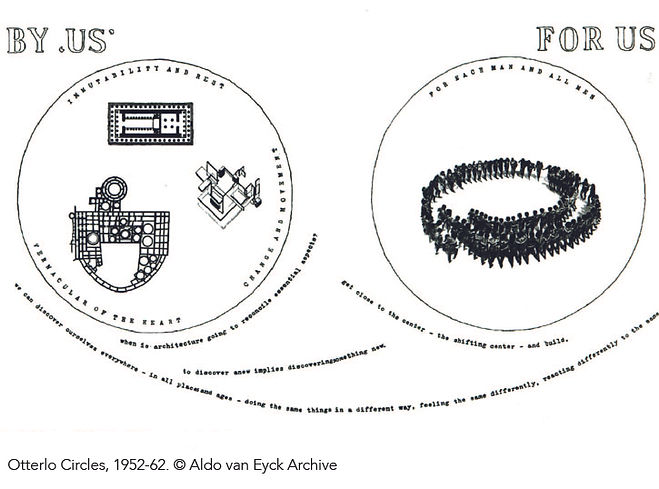Otterlo new & extra curricular

Dutch architect, Aldo Ernest van Eyck, presented for the first time his ‘Otterlo Circles’ ideogram at the last International Congresses of Modern Architecture in Otterlo, Holland, in 1959. A visual statement embodying how design of buildings and spaces can absorb a wider spectrum of cultural influences and social values. The goal being, making buildings and spaces around buildings more relatable, more human, and more meaningful places to be.

Schmela Haus, Dusselfdorf, Aldo van Eyck, 1971

Hubert Haus, Amsterdam, Aldo van Eyck, 1981

Aldo van Eyck, 'The Rebel Humanist' (1918-1999)
Otterlo puts enormous effort into engaging with the chemistry of the neighbourhoods in which we work. Piecing together an understanding of the community and morphology of place with an emphasis on its history and surviving heritage. Then using knowledge of these characteristics to craft buildings and the spaces around that may enhance the future lives of its inhabitants. A process which often generates original solutions. We are driven by approach rather than fashion.
Underpinning Otterlo’s approach is an engrained appreciation of the reciprocity between more relatable, more human, more meaningful, more sustainable places and the complex commercial endeavour necessary to make it all happen.

Coin Street Action Group, 1977, campaigning against plans for Southbank placing cold reason ahead of a willingness to understand the chemistry of the neighbourhood. Arguably their endeavours were a catalyst some decades later for a more holistic approach to urban planning.

"The Death of Congrès internationaux d'architecture moderne" at the last Congress meeting, Otterlo, Holland, 1959. Aldo van Eyck below left.
Notably, members of the 1959 Congress staged a symbolic death of the Congress and with it, the death of ‘Modernism’. Despite their enlightened intent, our industry continued to thrash out increasingly unrelatable, unexceptional and unsustainable ‘products’ onwards to and into the 21st Century. Yielding profound physical and emotional impacts on our lives. Other than a few gems here and there, eliciting deserved cynicism towards our industry’s ability to generate and regenerate our urban habitats.
Over the last decade or so there has been a vanguard of enlightened developers, planning officials and supporting agencies working hard to blast through the 20th Century ideas of progress. Creating an increasing number of new buildings and places that are popular and loved.
Otterlo is a part this vanguard; endeavouring to test and push the capacity of development to be ‘beautiful’. The name, Otterlo, is a nod to van Eyck’s intent and a sustained reminder of a suggestion, captured in his Otterlo Circles, of how this task may be achieved.
Aldo Ernest van Eyck in 1962 talking about enjoying a city, it had to be rediscovered through the eyes of its future – and present – users. In other words, through the eyes of children:
‘To consider the city is to find ourselves. To find the city is to rediscover the child. If the child rediscovers the city, the city will rediscover the child – it will rediscover us,’
The idea of the total remodelling of Amsterdam to replace it with a modernist city is appalling to us now. But for a young unknown architect to speak out against the popular school of the day showed great resilience and foresight.
The municipality went on to commission van Eyck to imagine more than 734 playgrounds built across Amsterdam on bomb sites between 1947 & 1978. These small but impactful interventions were to be catalysts for a more human scale of regeneration focusing on a ‘Play, Work, Life’ approach to communities.
'Re-meaning' bomb sites as playgrounds introduced a sense of place and occasion that stimulated dialogue in a war ravaged city around the potential of reknitting the broken fabric of neighbourhoods with new buildings and places that 'resonate with the past' whilst 're-establishing a confident present'.



